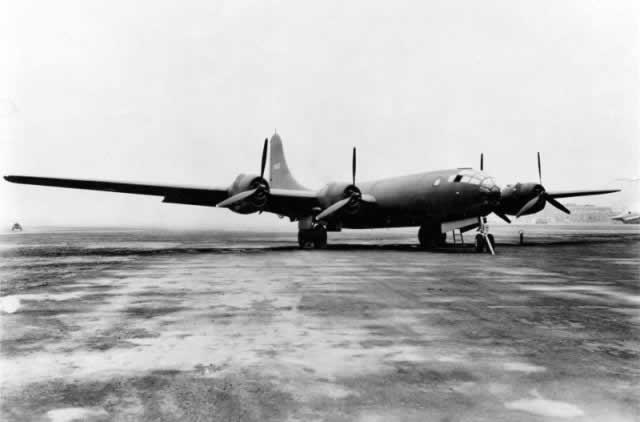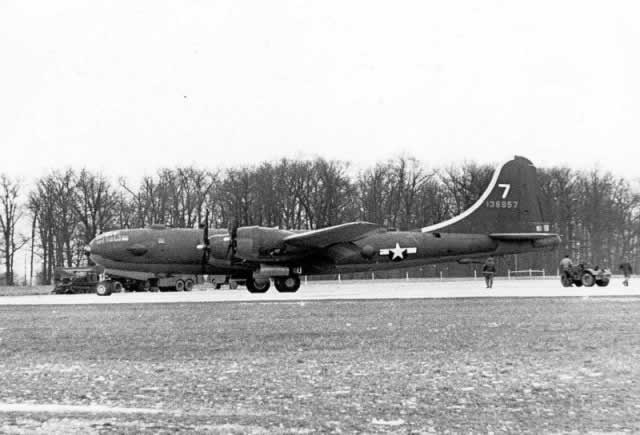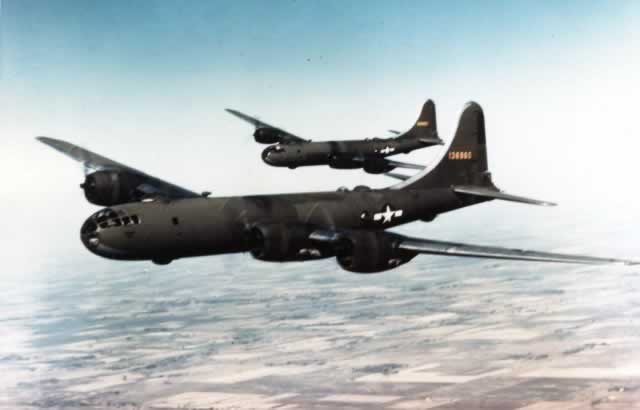Boeing B-29 Superfortress Development, Design and Specifications
Boeing began work on a pressurized long-range bomber in 1938. In December 1939, the Army Air Corps issued a formal specification for a so called "superbomber", capable of delivering 20,000 lbs of bombs to a target 2,667 miles distant, at a speed of 400 mph.
Bids were submitted by Lockheed, Consolidated, Douglas, and Boeing, which ultimately won the competition and subsequent contracts. An initial production order for 14 service test aircraft and 250 production bombers was placed in May 1941. The B-29 was one of the most advanced bombers of its time, featuring innovations such as a pressurized cabin, a central fire-control system, and remote-controlled machine gun turrets.
XB-29
The first three aircraft built were identified as the XB-29, with triple-bladed propellers.
The initial XB-29 (Serial Number 41-0002) was rolled out on the runway at Boeing Field, Seattle, and made its maiden flight on September 21, 1942, in front of almost all the Boeing employees who had contributed over 1,300,000 man hours to the project. This first XB-29 remained at Boeing throughout the war as a test aircraft.
The second XB-29 (Serial Number 41-0003) first flew on December 30, 1942. Shortly after noon on February 18, 1943, pilot Eddie Allen and crew were flight testing the second XB-29 when an engine fire developed. The port wing spar burned through and collapsed sending the huge bomber crashing into the Frye meat packing plant three miles from Boeing Field. All eleven men aboard the plane and 18 in the plant were killed instantly. details of the crash at the Aviation Safety Network
The third XB-29 prototype (S/N 41-18335) had its maiden flight in June of 1943. It incorporated extensive powerplant and equipment revisions, and was later moved to Boeing-Wichita to be part of the configuration of the assembly line. The aircraft was then transferred to the USAAF for armament and accelerated flight testing. This third XB-29 later crashed.
Boeing XB-29, S/N 41-0002, the first B-29 prototype |
 |
YB-29 Prototype
The YB-29 was an improved version of the XB-29 used for service testing. The engines were upgraded, and three-blade propellers of the XB-29 were changed to a four-blade type for the YB-29. The YB-29 also featured an improved fire control system and turret-mounted .50-cal. machine gun pairs.
The first YB-29 (S/N 41-36954) made its initial flight on June 26, 1943. A total of 14 YB-29 aircraft were manufactured at Boeing-Wichita. They provided the basis for continued B-29 development and testing, and eventually a flyable aircraft was ready for production.
Initial models were plagued with problems, and faced a constant series of modifications. The most common cause of maintenance headaches and catastrophic failures was the engine.
Boeing YB-29 S/N 41-36957 aircraft on tarmac |
 |
Boeing YB-29 aircraft in flight formation |
 |
XB-39 Superfortress
The XB-39 Superfortress was a one-aircraft testbed to prove that the B-29 could successfully utilize an alternative engine to the the air-cooled Wright R-3350 radial. The XB-39 would be fitted with Allison V-3420-17 liquid-cooled W24 inline engines.
The project prototype was YB-29, S/N 41-36954; it was was transferred in November of 1943 to the Fisher Body Aircraft Development Section of General Motors to be fitted with the Allison engines.
The first flight of the B-39 was made on December 9, 1944 at Cleveland, Ohio, and test flights of the B-39 were impressive. However, the B-29s in service were performing at a level that made continuance of the XB-39 not worthwhile. Consequently, the B-39 project was cancelled and no other types were built.
B-29
The most widely produced Superfortress model was the B-29, of which 2,537 aircraft were built.
The B-29 featured the first ever fully pressurized nose and cockpit in a bomber; an aft area for the crew was also pressurized. Since the bomb bays were not pressurized, a pressurized tunnel was devised to connect the fore and aft crew areas. A retractable tail bumper was provided for tail protection during nose-high takeoffs and landings.
B-29A
The Boeing B-29A was an improved version of the B-29, assembled only at Boeing's Renton plant. It featured an improved wing design and a four gun forward top turret. The new wing had a span 12 inches greater than the B-29 and was constructed in three pieces, a center section and two outboard sections, rather than the two sections of the earlier model. This allowed for greater strength and quicker installation at the factory plus maintenance in the field was easier.
All 1,122 B-29A aircraft were built at the Boeing Renton plant.
B-29 Superfortress TOPPS Card #51 (from the Planes Of The Past TOPPS Wings Friend or Foe Trading Card collection) |
B-29B
The Boeing B-29B was a modification of the basic B-29 design for use in the Pacific during World War II for low-level bombing raids against Japan. The B-29B had all defensive armament removed except for the tail turret. The 20mm cannon was removed and the two .50-cal. machine guns were aided by the installation of an AN/APG-15B radar fire control system.
All 311 B-29B aircraft were built at the Bell Atlanta-Marietta plant, between January and September of 1945.
Tupolev Tu-4
The Tupolev Tu-4 is a reversed-engineered variant of the Boeing B-29. Using B-29s which made emergency landings in the Soviet territory, Tupolev engineers built a clone of the B-29, with its first flight in May of 1947.
A total of 847 Tu-4s were reported built when production ended in 1952.
B-29 Superfortress Specifications
Armament: Eight .50-cal. machine guns in remote controlled turrets plus two .50-cal. machine guns and one 20mm cannon in tail; 20,000 lbs. of bombs
Engines: Four Wright R-3350s of 2,200 hp each
Maximum speed: 357 mph
Cruising speed: 220 mph
Range: 3,700 miles
Ceiling: 33,600 ft.
Span: 141 ft. 3 in.
Length: 99 ft.
Height: 27 ft. 9 in.
Weight: 133,500 lbs. maximum
More about the B-29 Superfortress |
|||||

